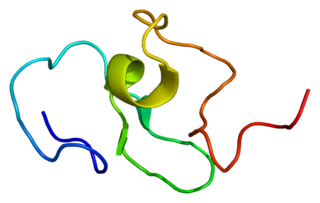
Lamin B2 is a protein that in humans is encoded by the LMNB2 gene. It is the second of two type B nuclear lamins, and it is associated with laminopathies.

Tyrosine-protein kinase, or Bromodomain adjacent to zinc finger domain, 1B (BAZ1B) is an enzyme that in humans is encoded by the BAZ1B gene.

Leucine-rich repeats and immunoglobulin-like domains protein 1 is a protein that in humans is encoded by the LRIG1 gene. It encodes a transmembrane protein that has been shown to interact with receptor tyrosine kinases of the EGFR family and with MET and RET.

Kaptin is a protein that in humans is encoded by the KPTN gene.

Cytochrome b561 is a protein that in humans is encoded by the CYB561 gene.

Rho-related BTB domain-containing protein 3 is a protein that in humans is encoded by the RHOBTB3 gene.

STAGA complex 65 subunit gamma is a protein that in humans is encoded by the SUPT7L gene.

RING finger protein 10 is a protein that in humans is encoded by the RNF10 gene.

SET and MYND domain-containing protein 4 is a protein that in humans is encoded by the SMYD4 gene.

Ubiquinone biosynthesis protein COQ9, mitochondrial, also known as coenzyme Q9 homolog (COQ9), is a protein that in humans is encoded by the COQ9 gene.

Phosphoribosyl pyrophosphate synthetase-associated protein 2 is a protein that in humans is encoded by the PRPSAP2 gene.

HMG box transcription factor BBX also known as bobby sox homolog or HMG box-containing protein 2 is a protein that in humans is encoded by the BBX gene.

WD repeat domain 47 is a protein that in humans is encoded by the WDR47 gene.

Protein FAM134C is a protein that in humans is encoded by the FAM134C gene.

caprin family member 2, also known as CAPRIN2, is a human gene.

tripartite motif containing 45, also known as TRIM45, is a human gene.

The family with sequence similarity 73, member B, also known as FAM73B, is a human gene.

Eukaryotic translation initiation factor 4E family member 3 is a protein that in humans is encoded by the EIF4E3 gene.

Mitochondrial 2-oxodicarboxylate carrier also known as solute carrier family 25 member 21 (SLC25A21) is a protein that in humans is encoded by the SLC25A21 gene.

NOP2/Sun domain family, member 2 is a protein that in humans is encoded by the NSUN2 gene. Alternatively spliced transcript variants encoding different isoforms have been noted for the gene.















